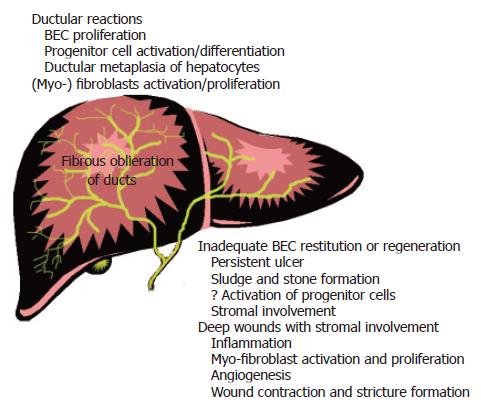Copyright
©2006 Baishideng Publishing Group Co.
World J Gastroenterol. Jun 14, 2006; 12(22): 3512-3522
Published online Jun 14, 2006. doi: 10.3748/wjg.v12.i22.3512
Published online Jun 14, 2006. doi: 10.3748/wjg.v12.i22.3512
Figure 4 Summary of the most common “wound repair” reactions that contribute to the development of chronic liver disease and liver cancers.
Although all of the processes described in the text can occur at any site in the biliary tree, certain types of responses are more common at certain sites. For example, in the extra-hepatic and large intra-hepatic bile ducts (lower right), inadequate or ineffectual epithelial restitution or proliferation results in persistent ulcers and stone and sludge formation. This, in turn, leads to possible activation of progenitor cells and stromal involvement, which can also be triggered by “deep wounding” of the large ducts. Stromal involvement is usually accompanied by inflammation, angiogenesis, and activation and proliferation of myofibroblasts. All of these processes contribute to wound contraction and stricture formation, which is one of the most common and clinically significant problems in the large ducts.
- Citation: Demetris AJ, III JGL, Specht S, Nozaki I. Biliary wound healing, ductular reactions, and IL-6/gp130 signaling in the development of liver disease. World J Gastroenterol 2006; 12(22): 3512-3522
- URL: https://www.wjgnet.com/1007-9327/full/v12/i22/3512.htm
- DOI: https://dx.doi.org/10.3748/wjg.v12.i22.3512









